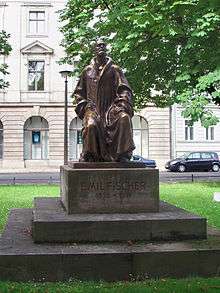Emil Fischer
| Hermann Emil Fischer | |
|---|---|
 Hermann Emil Fischer | |
| Born |
Hermann Emil Louis Fischer 9 October 1852 Euskirchen, Rhine Province |
| Died |
15 July 1919 (aged 66) Berlin, Germany |
| Nationality | Germany |
| Alma mater |
University of Bonn University of Strasbourg |
| Known for | Study of sugars & purines |
| Awards |
|
| Scientific career | |
| Fields | Chemistry |
| Institutions |
University of Munich (1875–81) University of Erlangen (1881–88) University of Würzburg (1888–92) University of Berlin (1892–1919) |
| Doctoral advisor | Adolf von Baeyer |
| Doctoral students |
Alfred Stock Otto Diels Otto Ruff Walter A. Jacobs Ludwig Knorr Oskar Piloty Julius Tafel |
Hermann Emil Louis Fischer FRS FRSE FCS (9 October 1852 – 15 July 1919) was a German chemist and 1902 recipient of the Nobel Prize in Chemistry. He discovered the Fischer esterification. He also developed the Fischer projection, a symbolic way of drawing asymmetric carbon atoms. He never used his first given name, and was known throughout his life simply as Emil Fischer.[2][3][4][5]
Early years
Fischer was born in Euskirchen, near Cologne, the son of Laurenz Fischer, a businessman, and his wife Julie Poensgen. After graduating he wished to study natural sciences, but his father compelled him to work in the family business until determining that his son was unsuitable. Fischer then attended the University of Bonn in 1871, but switched to the University of Strasbourg in 1872.[6] He earned his doctorate in 1874 under Adolf von Baeyer[6] with his study of phthalein and was appointed to a position at the university.
Research
Fischer is noted for his work on sugars: among other work, the organic synthesis of D-(+)-glucose[7] and purines (including the first synthesis of caffeine).
Fischer was also instrumental in the discovery of barbiturates, a class of sedative drugs used for insomnia, epilepsy, anxiety, and anesthesia. Along with the physician Josef von Mering, he helped to launch the first barbiturate sedative, barbital, in 1904.[8]
Honours, awards, and legacy

In 1897 he put forward the idea to create the International Atomic Weights Commission. Fischer was elected a Foreign Member of the Royal Society (ForMemRS) in 1899.[1]
Many names of chemical reactions and concepts are named after him:
(Fischer–Tropsch process is named after Franz Emil Fischer a chemist who was no relation, head of the Max Planck Institute for Coal Research in Muelheim.)
References
- 1 2 "Fellows of the Royal Society". London: Royal Society. Archived from the original on 2015-03-16.
- ↑ Horst Kunz (2002). "Emil Fischer – Unequalled Classicist, Master of Organic Chemistry Research, and Inspired Trailblazer of Biological Chemistry". Angewandte Chemie International Edition. 41 (23): 4439–4451. doi:10.1002/1521-3773(20021202)41:23<4439::AID-ANIE4439>3.0.CO;2-6. PMID 12458504.
- ↑ Lichtenthaler, F. W. (1992). "Emil Fischers Beweis der Konfiguration von Zuckern: eine Würdigung nach hundert Jahren". Angewandte Chemie. 104 (12): 1577–1593. doi:10.1002/ange.19921041204.
- ↑ Forster, Martin Onslow (1 January 1920). "Emil Fischer memorial lecture". Journal of the Chemical Society, Transactions. 117: 1157–1201. doi:10.1039/CT9201701157.
- ↑ Biography Biography of Fischer from Nobelprize.org website
- 1 2 Eduard, Farber (1970–80). "Fischer, Emil Hermann". Dictionary of Scientific Biography. 5. New York: Charles Scribner's Sons. pp. 1–5. ISBN 978-0-684-10114-9.
- ↑ Fischer, Emil (1890). "Synthese des Traubenzuckers". Berichte der deutschen chemischen Gesellschaft. 23: 799–805. doi:10.1002/cber.189002301126.
- ↑ López-Muñoz; et al. "The History of Barbiturates". PMC 2424120. Missing or empty
|url=(help)
External links
- Nobel Lecture Syntheses in the Purine and Sugar Group from Nobelprize.org website
- Eminent Chemists of Our Time By Benjamin Harrow pages 216–239, published 1920 by Von Nostrand Company at books.google.com.
- Guide to the Emil Fischer Papers at The Bancroft Library
- Text-book of Physiological Chemistry in Thirty Lectures by Emil Abderhalden, translated by William Thomas Hall and George Defren; published 1908 by Wiley Company, has many technical references to Fischer's work in Chemistry.
- American Journal of Diseases of Children 1911 volume 2 by the American Medical Association also refers to Fischer's work.
- An Introduction to the History of Medicine: With Medical Chronology by Fielding Hudson Garrison, page 708 refers to Fischer and Merings discovery of the drugs veronal(1904) and proponal(1905), published 1921 by Saunders Company.
- 1914 Year Book of the American Pharmaceutical Association, page 438 abstracts Fischer and Strauss's work on Phenol-Glucosides – Synthetic Production from Berlin d.D Chem. Germany, page 45(1912) No. 12.

- "Fischer, Emil". New International Encyclopedia. 1905.
- "Fischer, Emil". Encyclopædia Britannica (11th ed.). 1911.
- "Fischer, Emil". Encyclopedia Americana. 1920.
